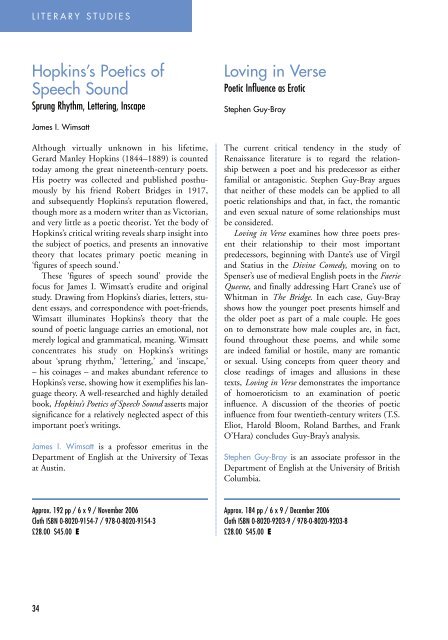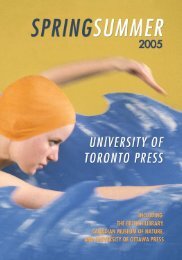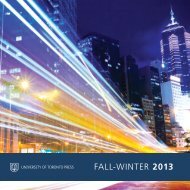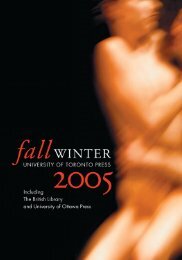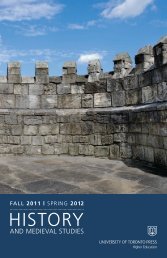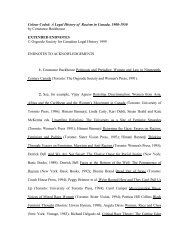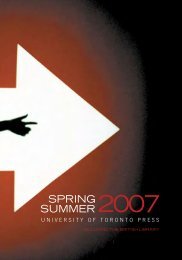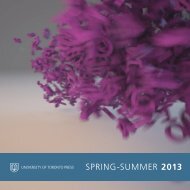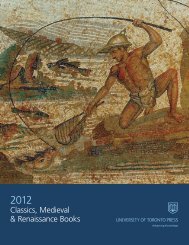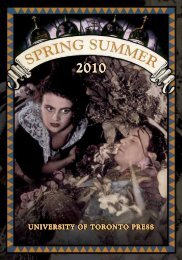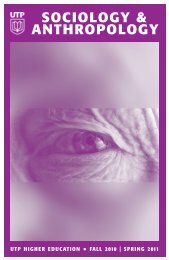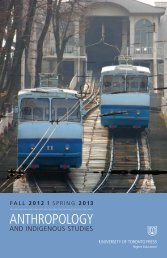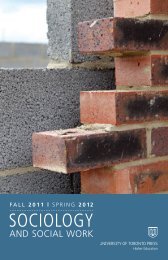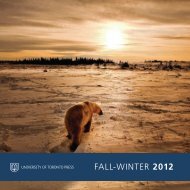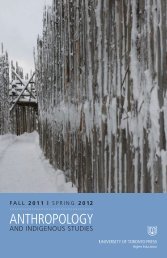Fall/Winter 2006 - University of Toronto Press Publishing
Fall/Winter 2006 - University of Toronto Press Publishing
Fall/Winter 2006 - University of Toronto Press Publishing
Create successful ePaper yourself
Turn your PDF publications into a flip-book with our unique Google optimized e-Paper software.
L I T E R A R Y S T U D I E S<br />
Hopkins’s Poetics <strong>of</strong><br />
Speech Sound<br />
Sprung Rhythm, Lettering, Inscape<br />
Loving in Verse<br />
Poetic Influence as Erotic<br />
Stephen Guy-Bray<br />
James I. Wimsatt<br />
Although virtually unknown in his lifetime,<br />
Gerard Manley Hopkins (1844–1889) is counted<br />
today among the great nineteenth-century poets.<br />
His poetry was collected and published posthumously<br />
by his friend Robert Bridges in 1917,<br />
and subsequently Hopkins’s reputation flowered,<br />
though more as a modern writer than as Victorian,<br />
and very little as a poetic theorist. Yet the body <strong>of</strong><br />
Hopkins’s critical writing reveals sharp insight into<br />
the subject <strong>of</strong> poetics, and presents an innovative<br />
theory that locates primary poetic meaning in<br />
‘figures <strong>of</strong> speech sound.’<br />
These ‘figures <strong>of</strong> speech sound’ provide the<br />
focus for James I. Wimsatt’s erudite and original<br />
study. Drawing from Hopkins’s diaries, letters, student<br />
essays, and correspondence with poet-friends,<br />
Wimsatt illuminates Hopkins’s theory that the<br />
sound <strong>of</strong> poetic language carries an emotional, not<br />
merely logical and grammatical, meaning. Wimsatt<br />
concentrates his study on Hopkins’s writings<br />
about ‘sprung rhythm,’ ‘lettering,’ and ‘inscape,’<br />
– his coinages – and makes abundant reference to<br />
Hopkins’s verse, showing how it exemplifies his language<br />
theory. A well-researched and highly detailed<br />
book, Hopkins’s Poetics <strong>of</strong> Speech Sound asserts major<br />
significance for a relatively neglected aspect <strong>of</strong> this<br />
important poet’s writings.<br />
James I. Wimsatt is a pr<strong>of</strong>essor emeritus in the<br />
Department <strong>of</strong> English at the <strong>University</strong> <strong>of</strong> Texas<br />
at Austin.<br />
The current critical tendency in the study <strong>of</strong><br />
Renaissance literature is to regard the relationship<br />
between a poet and his predecessor as either<br />
familial or antagonistic. Stephen Guy-Bray argues<br />
that neither <strong>of</strong> these models can be applied to all<br />
poetic relationships and that, in fact, the romantic<br />
and even sexual nature <strong>of</strong> some relationships must<br />
be considered.<br />
Loving in Verse examines how three poets present<br />
their relationship to their most important<br />
predecessors, beginning with Dante’s use <strong>of</strong> Virgil<br />
and Statius in the Divine Comedy, moving on to<br />
Spenser’s use <strong>of</strong> medieval English poets in the Faerie<br />
Queene, and finally addressing Hart Crane’s use <strong>of</strong><br />
Whitman in The Bridge. In each case, Guy-Bray<br />
shows how the younger poet presents himself and<br />
the older poet as part <strong>of</strong> a male couple. He goes<br />
on to demonstrate how male couples are, in fact,<br />
found throughout these poems, and while some<br />
are indeed familial or hostile, many are romantic<br />
or sexual. Using concepts from queer theory and<br />
close readings <strong>of</strong> images and allusions in these<br />
texts, Loving in Verse demonstrates the importance<br />
<strong>of</strong> homoeroticism to an examination <strong>of</strong> poetic<br />
influence. A discussion <strong>of</strong> the theories <strong>of</strong> poetic<br />
influence from four twentieth-century writers (T.S.<br />
Eliot, Harold Bloom, Roland Barthes, and Frank<br />
O’Hara) concludes Guy-Bray’s analysis.<br />
Stephen Guy-Bray is an associate pr<strong>of</strong>essor in the<br />
Department <strong>of</strong> English at the <strong>University</strong> <strong>of</strong> British<br />
Columbia.<br />
Approx. 192 pp / 6 x 9 / November <strong>2006</strong><br />
Cloth ISBN 0-8020-9154-7 / 978-0-8020-9154-3<br />
£28.00 $45.00 E<br />
Approx. 184 pp / 6 x 9 / December <strong>2006</strong><br />
Cloth ISBN 0-8020-9203-9 / 978-0-8020-9203-8<br />
£28.00 $45.00 E<br />
34


